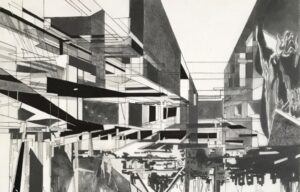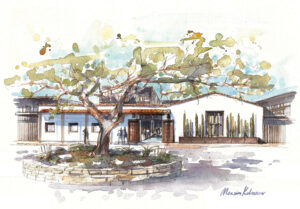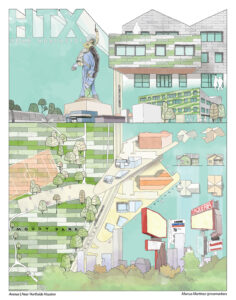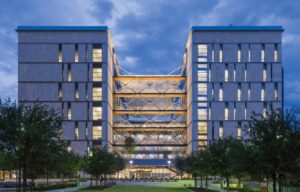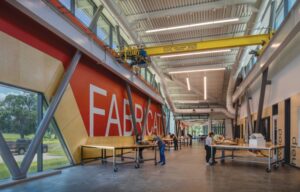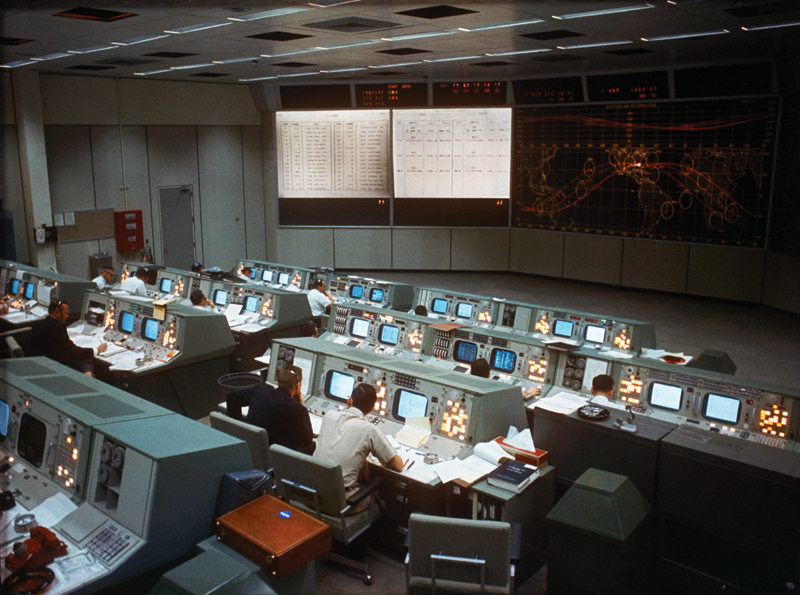
Future Places
The past is but the beginning of a beginning, and all that is and has been is but the twilight of the dawn.
— H.G. Wells, “The Discovery of the Future,” 1901
Founded six decades ago, the National Aeronautics and Space Administration (NASA) is at a notable moment in its evolution. The nonmilitary government agency created as a nationalistic response to the dystopian reality of the Cold War’s space race became a rallying point of international optimism “devoted to peaceful purposes for the benefit of all mankind.” The nation’s interest in exploring neighboring planetary bodies waned for several decades after the world-enthralling moon landings, but NASA is once again embarking on a monumental manned mission — this time to Mars.
Against this backdrop of renewed focus and purpose, the agency finds itself simultaneously embracing the significance of its history while ramping up its ongoing pursuit of scientific excellence in human space exploration. Two architectural projects embody this cultural cusp moment at NASA: the restoration of the historic Mission Operations Control Room #2 (MOCR-2, completed in 1965) and the state-of-the-art Human Health and Performance Laboratory (Building 21, completed in 2017).
MOCR-2 Restoration
With President Kennedy’s challenge to put Americans on the moon, manned space flight became NASA’s number one mission. This led to the establishment of the Manned Spacecraft Center in 1961, 25 miles southeast of Houston in Clear Lake, Texas on 1,620 acres of land donated by Rice University. Renamed the Lyndon B. Johnson Space Center (JSC) in 1973, it is the foremost research and development facility for manned spacecraft in the world and the focal point for all manned space activity in the United States. As such, it holds an exceptional place in history.
The history of human space flight is inextricably linked to the Christopher C. Kraft, Jr. Mission Control Center Building 30. Inside is MOCR-2, where U.S. manned missions since Gemini 4 have been directed, including Apollo 11 and the first moon landing 50 years ago this July. The slow journey to preserve this history by restoring the control room to its Apollo-era configuration began in the 1980s.
In 1985, the National Park Service granted MOCR-2 and several other sites on the Brutalist campus status as a National Historic Landmark. This designation came about thanks to the efforts of many, including then Deputy State Historic Preservation Officer Stan Graves, FAIA. The entire JSC, which boasts the largest collection of midcentury buildings in the United States, is considered a Historic District and, in 2016, was listed on the National Register of Historic Places. However, as with many preservation projects that seem straightforward at the outset, the process of restoring MOCR-2 to the historic moment of the moon landing wound up being far from easy.
Since the control room is part of a working facility, tensions around its restoration began soon after the historic designation was conferred: NASA’s Flight Operations group needed to modernize MOCR-2 for its role directing newly commissioned space shuttle flights, but the Texas Historical Commission wanted to retain its historic configuration. NASA officials declared the proposed restoration incompatible with the shuttle operation upgrade, and so a struggle ensued over the future of the control room.
Everyone agreed that MOCR-2 was of great significance, as it was ingrained in the memories of millions of people worldwide —everyone, that is, but NASA officials. They seemed to be focused exclusively on their mission of scientific exploration, unable to link MOCR-2’s past relevance with its future roles. Stan Graves remarked at the time, “This is our one opportunity to preserve something like this.” Some progress was being made with JSC, but then Washington stepped in and tried to de-register the entire historic district in order to proceed with modernization. From there, it got ugly.
In fact, some NASA personnel sought to preserve this unique piece of human history, and their involvement proved contentious: Retired Apollo-era flight controllers voiced their concern, headed by famed flight director Eugene “Gene” Kranz, who had led the room during both Apollo 11’s Tranquility Base moon landing and Apollo 13’s “Houston, we have a problem” flight. Kranz, along with assistant flight director Ed Fendell, spoke out publicly, ultimately creating enormous public pressure with a scathing “nuclear letter” that called out shortsighted NASA officials. The letter was a turning point in the project and garnered Kranz and Fendell a lifetime ban from NASA facilities (which has since been rescinded).
A tour of Mission Control Center and MOCR-2 during the National Trust for Historic Preservation’s conference in Houston in 2016 prompted an editorial in the Houston Chronicle entitled “Save Mission Control” that called for preservation of the former NASA nerve center that “put Houston on the map.” This galvanized public opinion and kicked off serious fundraising and restoration plans. However, the project had really begun years earlier with the stoic individual efforts of JSC Real Property and Historic Preservation Officer Sandra Tetley.
Tetley, who had restored her own historic home on Galveston Island, followed directions spelled out in the original 1985 designation and in subsequent dealings with the Texas Historical Commission requiring Mission Control Room artifacts to be retained and stored. She also took it upon herself to gather up additional items throughout JSC that otherwise would have been thrown away. Even this part of the project was difficult in an environment of forward-looking technicians and engineers who discarded anything not immediately useful. So Tetley and one other employee on the 15,000-person campus are the only holders of keys to a fenced-in corner of an anonymous “Raiders of the Lost Arc”-style warehouse that holds the 1960s treasures they scrounged from across the campus.
“If it weren’t for the THC putting its foot down,” Tetley says, “none of these items would be here and the project would not be possible.” The six-year project moved past NASA roadblocks and began in earnest in 2014 with the development of a Rough Order of Magnitude estimate by Houston-based Stern and Bucek Architects. The majority of the $5 million project funding has come from a Kickstarter campaign, donations from The City of Webster, and NASA.
David Bucek, FAIA, notes that restoring MOCR-2 has taken longer than did planning and executing the Apollo 11 mission. He adds that, as is too often the case with preservation, educating all the participating groups can be a real challenge. Gaps in funding, the many starts and stops, and at times the owner’s resistance prolonged the project. However, he has managed to stay out of the political fray, and his team has used the frequent interruptions to research and source period items, improving the result by going above and beyond to do the right thing. This extra effort has included countless hours scouring photos to find matches for coffee cups, ashtrays, and telephones on eBay, as well as re-creating finish materials long out of production.
Though hidden behind various renovations over the years, several original materials were discovered during the initial room investigations. The original wallpaper was found under a wall bracket, electrical panel, and thermostat cover, and the original carpet, under a pneumatic tube console that was hard piped and proved too difficult to remove in a previous renovation. Fifty-year-old replacement materials, however, cannot simply be bought off the shelf.
Bucek and his team were able to locate the rollers — worn from many years of use — that made the original wallpaper. Though the re-created wallpaper is a little less finely textured, the rollers still yield an excitingly accurate detail. Similarly, the original carpet was made with a two-direction weave, which is no longer used, so many iterations of a tufted version of the pattern were created to choose from. Also a challenge to reproduce were the chairs in the viewing room. The team worked with a local Steelcase rep and the original archive in Michigan to find the original specifications and swatches. The search took more than a year, and ultimately, a match for the fabric was handmade by Texas Weaving Guild member Mary Welch, wife of a local architect. Another example of “above and beyond”: the effort made to capture the hole pattern of the acoustic ceiling panels, which had to be mapped using pushpins, then pressed onto new panels and each hole hand-drilled.
Tetley says all this amazing effort has not gone unnoticed by the NASA administrators who once opposed the project. “The bandwagon is starting to get crowded,” she says. More and more officials are beginning to embrace MOCR-2’s immense significance, as the quality of restoration work from project managers, architects, engineers, and craftspeople begins to be celebrated outside JSC.
In the end, though, Tetley wants the focus to remain on “the stories of the people who worked as flight controllers in the room.” The project is set to be completed by July 20 this year for the 50th anniversary celebration of the first lunar moon landing. The plan is for MOCR-2 to be open after that to the public as part of Space Center Houston’s regular tours.
Human Health and Performance Laboratory, Building 21
While the history of NASA is being secured and celebrated in the Mission Control Center, the future of humans in space is being carefully considered by scientists just across the street in the newest building at JSC — the Human Health and Performance (HHP) Laboratory in Building 21, which represents the latest thinking in building technology and office organization and is an indicator of NASA’s commitment to providing model working environments for its employees.
The new facility takes a people-at-center approach; it is designed to attract top scientists and support their efforts to keep astronauts healthy while exploring space. As JSC’s 10th LEED-certified building, the 118,000-sf LEED Gold-certified Laboratory conveys an abundance of natural lighting to the greatest number of people. Care was taken to reveal as much of the interior and exterior of the building as possible so people can see each other working, relaxing, and gathering throughout their workday.
The overarching concept of Building 21 is to enhance interdisciplinary integration. Providing flexible, centralized, and co-located work environments encourages collaboration among different disciplines, combining programs from seven separate aging, substandard, or obsolete buildings and bringing together their scientists under one roof. “Cross-pollination” — through mixed office arrangements and outdoor gathering spaces — leads to mutual respect: The idea is to foster joint solutions to NASA’s exploration challenges, going forward.
This strategy, shepherded by HDR architect Dennis Patrick, AIA, and his team, came about as the result of their being embedded with NASA researchers and administrators for two years of the more-than-six-year project. Spending multiple week-long sessions during the programming and design phase allowed Patrick and his team to fully understand not only how the scientists worked, but also how their systems and equipment supported them. The outcome was an open lab bench design for research space that meant that, where possible, large lab space was allotted to be shared across disciplines instead of maintaining a collection of smaller, isolated spaces.
Convinced by visits to new facilities at Arizona State University, Georgia Tech, and the Centers for Disease Control and Prevention labs in Atlanta, NASA administrators and scientists became invested in the cross-collaborative concept and worked closely with Patrick’s team throughout the process. Representatives of each discipline negotiated space and equipment needs and the particulars of sharing resources across 17 labs and 300 people. This led to the design of two wings, one for biomedical and environmental sciences, and the other for health and performance — each with labs, offices, and shared amenities.
The biomedical and environmental sciences wing features a unique interior lab support spine of utilities, shared storage, and service equipment flanked by the open bench labs. This decision allowed the labs to face outward with views of the outdoors and its updates on the weather and time of day. In the health and performance wing, a large high-bay performance lab has flexible room dividers, strengthened floor slabs, and overhead structure for supporting heavy testing equipment for humans in motion. A grid of floor ducts for electrical power, grounding, and data cabling allows researchers to shift the setup for testing purposes, for mock-ups, and for yet-to-be-invented equipment that will become part of the continuous advance of research methods. The administration took the additional step of distributing scientists from different disciplines throughout the offices and cubicles to make possible daily informal interactions.
The interdisciplinary theme is reflected in the site orientation where the buildings are positioned to link the historic and future sides of campus. Space and earth come together in the echoing of circular forms and in the siting of the exterior courtyard. The courtyard itself connects to nature and takes advantage of views of a test site for a new program called Sustainable Landscapes developed by the Lady Bird Johnson Wildflower Center in Austin and the American Association of Landscape Architects. Its stated purpose is “to support the culture and values of the local community, improve and restore desired wildlife habitat, and contribute to the overall health of the local ecosystem.”
The efforts of HDR and the NASA project team to create a new culture by designing shared space already paid dividends in its first year of operation, when researchers from different disciplines discovered a relationship between cardiovascular health and vision problems that might not have been established had they been working in separate buildings, as before. Moreover, the idea of creating shared physical and mental space is spreading to other parts of NASA: A new initiative stemming from the Building 21 collaborative work environment brings NASA researchers and external leaders from public and private organizations together to discuss specific topics or problems. NASA is actively seeking ways to foster healthy discussion and fresh perspectives based on interdisciplinary insights.
Future Places
These seemingly disparate contemporaneous architectural projects at the Johnson Space Center — the MOCR-2 preservation project and Building 21 — point to an interesting moment in which NASA is being forced to consider the past at the same time it gears up to push into the future.
In the case of MOCR-2, the painstaking architectural re-crafting of a site that is of significance to all humankind preserves for future generations a monumental moment in time that, as technical project manager Dr. Adam Graves put it, “divides everything that came before from everything that comes after.” At the same moment, a thoughtful and thorough design process for a new Building 21 is birthing a fresh culture of collaboration that directly revitalizes the continuing mission of healthy human exploration of space.
This juxtaposition of preservation and innovation shows us the essential connection between the practice of architecture and the manifestation of culture. It also, perhaps, reminds us to maintain a considered balance of past and present in our architectural places as we discover, explore, and build our own future.
Riley Triggs, AIA, is an architect for the Texas Historical Commission. He lives in Austin.

Riley Triggs, AIA, is a professor of architectural history and design and the lead project manager for the City of Austin’s new Austin Convention Center.
Also from this issue







